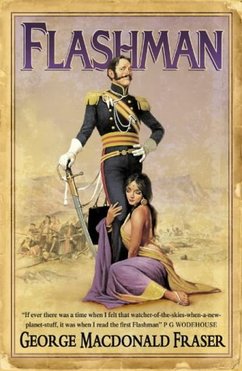
Sir Harry Paget Flashman is a fictional character created by Thomas Hughes (1822–1896) in the semi-autobiographical Tom Brown's School Days (1857) and later developed by George MacDonald Fraser (1925–2008). Harry Flashman appears in a series of 12 of Fraser's books, collectively known as The Flashman Papers, with covers illustrated by Arthur Barbosa and Gino D’Achille. Flashman was played by Malcolm McDowell in the Richard Lester 1975 film Royal Flash.

The Battle of Inkerman was fought during the Crimean War on 5 November 1854 between the allied armies of Britain and France against the Imperial Russian Army. The battle broke the will of the Russian Army to defeat the allies in the field, and was followed by the Siege of Sevastopol. The role of troops fighting mostly on their own initiative due to the foggy conditions during the battle has earned the engagement the name "The Soldier's Battle."

Field Marshal FitzRoy James Henry Somerset, 1st Baron Raglan,, known before 1852 as Lord FitzRoy Somerset, was a British Army officer. When a junior officer, he served in the Peninsular War and the Waterloo campaign, latterly as military secretary to the Duke of Wellington. He also took part in politics as Tory Member of Parliament for Truro, before becoming Master-General of the Ordnance.
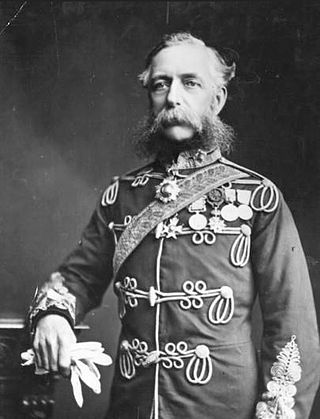
Lieutenant-General James Thomas Brudenell, 7th Earl of Cardigan, styled as Lord Cardigan, was an officer in the British Army who commanded the Light Brigade during the Crimean War, leading its charge at the Battle of Balaclava.

The Battle of Balaclava, fought on 25 October 1854 during the Crimean War, was part of the Siege of Sevastopol (1854–55), an Allied attempt to capture the port and fortress of Sevastopol, Russia's principal naval base on the Black Sea. The engagement followed the earlier Allied victory in September at the Battle of the Alma, where the Russian General Menshikov had positioned his army in an attempt to stop the Allies progressing south towards their strategic goal. Alma was the first major encounter fought in the Crimean Peninsula since the Allied landings at Kalamita Bay on 14 September, and was a clear battlefield success; but a tardy pursuit by the Allies failed to gain a decisive victory, allowing the Russians to regroup, recover and prepare their defence.

George Charles Bingham, 3rd Earl of Lucan,, styled Lord Bingham before 1839, was an Anglo-Irish peer and military officer. He was one of three men, along with Louis Nolan and Lord Raglan, responsible for the fateful order during the Battle of Balaclava in October 1854 that led to the Light Brigade commander, the Earl of Cardigan, leading the Charge of the Light Brigade. He was subsequently promoted to field marshal. He was also a ruthless landlord during the Great Famine in Ireland, evicting thousands of his tenants and renting his land to wealthy ranchers. He also came up with a solution that allowed Jews to sit in Parliament.

The Thin Red Line described an episode of the Battle of Balaclava on 25 October 1854, during the Crimean War. In the incident, around 500 men of the 93rd Sutherland Highlanders led by Sir Colin Campbell, aided by a small force of 100 walking wounded, 40 detached Guardsmen, and supported by a substantial force of Turkish infantrymen, formed a line of fire against the Russian cavalry. Previously, Campbell's Highland Brigade had taken part in actions at the Battle of Alma and the Siege of Sevastopol. There were more Victoria Crosses presented to the Highland soldiers at that time than at any other. The event was lionised in the British press and became an icon of the qualities of the British soldier in a war that was arguably poorly managed and increasingly unpopular.
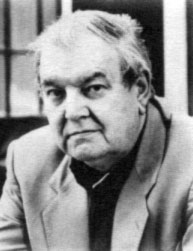
George MacDonald Fraser was a Scottish author and screenwriter. He is best known for a series of works that featured the character Flashman. Over the course of his career he wrote eleven novels and one short-story collection in the Flashman series of novels, as well as non-fiction, short stories, novels and screenplays—including those for the James Bond film Octopussy, The Three Musketeers and an adaptation of his own novel Royal Flash.

Count Nikolay Pavlovich Ignatyev, a Russian statesman and diplomat, became best known for his aggressive expansionism in support of Russian imperialism. In dealing with China, he secured a large slice of Chinese territory by the multi-lateral Treaty of Peking in 1860. As the Russian ambassador to the Ottoman Empire from 1864 to 1877, he worked to stir up pan-Slavic feeling and nationalism against the Ottomans, and had some responsibility for the Bulgarian rebellion of April 1876. He encouraged his government to declare war on Turkey in 1877, and after the decisive Russian victory he negotiated the Treaty of San Stefano in 1878. It heralded greatly strengthened Russian influence in the Balkans. However Britain and Austria-Hungary intervened and forced the retraction of the treaty. As Minister of the Interior, Count Ignatyev promoted ultraconservative and Slavic-nationalist policies.
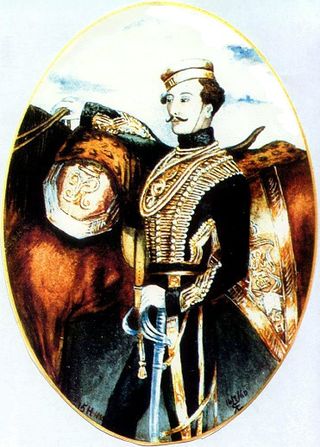
Lewis Edward Nolan, known to his family as Louis Nolan and in Austrian service as Ludwig Nolan was a British Army officer and cavalry tactician best known for his role and death in the Charge of the Light Brigade during the Crimean War. Born to an infantry officer and minor official and his wife, Nolan was educated at the Austrian Inhaber Pioneer School at Tulln, where he was noted as an enthusiastic horseman and military theorist. After early graduation he was commissioned as a subaltern in the 10th Austrian Hussar regiment, serving in Austria, Hungary and on the Polish frontier, where he again became known for his horsemanship and was promoted to senior lieutenant. Due to the nepotism in the Austro-Hungarian armed forces, Nolan transferred to the British Army as a cornet in the 15th Light Dragoons.

General Sir James Yorke Scarlett was a British Army officer and hero of the Crimean War who led the Charge of the Heavy Brigade during the Battle of Balaclava on 25 October 1854.

Flashman is a 1969 novel by George MacDonald Fraser. It is the first of the Flashman novels.
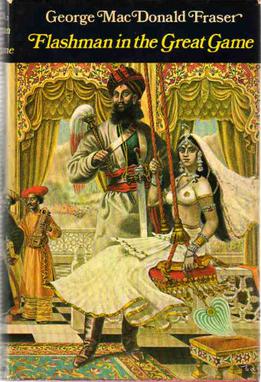
Flashman in the Great Game is a 1975 novel by George MacDonald Fraser. It is the fifth of the Flashman novels.

Flashman and the Dragon is a 1985 novel by George MacDonald Fraser. It is the eighth of the Flashman novels.

The Charge of the Light Brigade is a 1968 British DeLuxe Color satirical war film made by Woodfall Film Productions and distributed by United Artists, depicting parts of the Crimean War and the eponymous charge. It was directed by Tony Richardson and produced by Neil Hartley. Its animated credits and linking passages were created by Richard Williams, drawing on the satirical use of Victorian-era jingoistic images. This film features Richardson's daughters Natasha and Joely in their debuts.

The Charge of the Light Brigade is a 1936 American historical adventure film from Warner Bros., starring Errol Flynn and Olivia de Havilland. It was directed by Michael Curtiz and produced by Samuel Bischoff, with Hal B. Wallis as the executive producer. The film's screenplay is by Michael Jacoby and Rowland Leigh, from a story by Michael Jacoby, and based on the 1854 poem "The Charge of the Light Brigade" by Alfred, Lord Tennyson. The music score was composed by Max Steiner, his first for Warner Bros., and the cinematography was by Sol Polito. Scenes were shot at the following California locations: Lone Pine, Sherwood Lake, Lasky Mesa, Chatsworth, and Sonora. The Sierra Nevada mountains were used for the Khyber Pass scenes.

Frances Isabella Duberly was an English diarist who wrote a journal of her experiences on campaign in the Crimean War and the Indian Rebellion of 1857. Her husband, Captain Henry Duberly, was paymaster to the 8th Royal Irish Hussars, part of the British light cavalry that took part in the Charge of the Light Brigade. Duberly's journal of her time in Crimea was published as Journal Kept During the Russian War (1856). It not only includes eye-witness accounts, but is also a record of gossip and rumours circulating in the British Army.

The Charge of the Light Brigade was a military action undertaken by British light cavalry against Russian forces during the Battle of Balaclava in the Crimean War, resulting in many casualties to the cavalry. On 25 October 1854, the Light Brigade, led by Lord Cardigan, mounted a frontal assault against a Russian artillery battery which was well prepared with excellent fields of defensive fire. The charge was the result of a misunderstood order from the commander in chief, Lord Raglan, who had intended the Light Brigade to attack a different objective for which light cavalry was better suited, to prevent the Russians from removing captured guns from overrun Turkish positions. The Light Brigade made its charge under withering direct fire and reached its target, scattering some of the gunners, but was forced to retreat immediately.
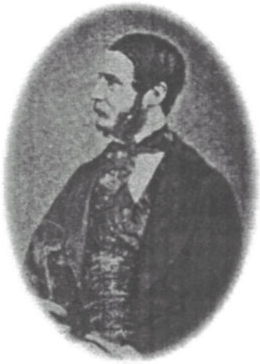
Lieutenant-Colonel William Morris was a British Army officer who rode in the Charge of the Light Brigade.
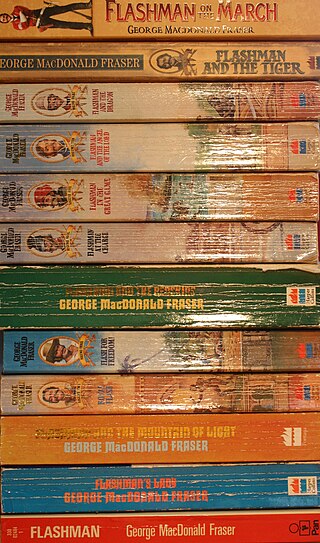
The Flashman Papers is a series of novels and short stories written by George MacDonald Fraser, the first of which was published in 1969. The books centre on the exploits of the fictional protagonist Harry Flashman. He is a cowardly British soldier, rake and cad who is placed in a series of real historical incidents between 1839 and 1894. While the incidents and much of the detail in the novels have a factual background, Flashman's actions in the stories are either fictional, or Fraser uses the actions of unidentified individuals and assigns them to Flashman. Flashman is a character in the 1857 novel by Thomas Hughes, Tom Brown's School Days; Hughes' version of the character is a bully at Rugby School who is expelled for drunkenness. The character was then developed by Fraser, and appeared in the 1969 novel Flashman. Fraser went on to write a total of eleven novels and one collection of short stories featuring the character.



















